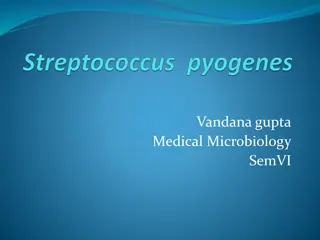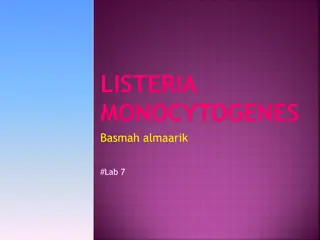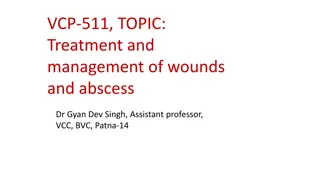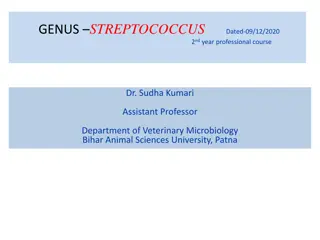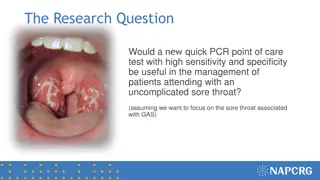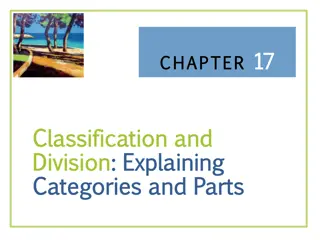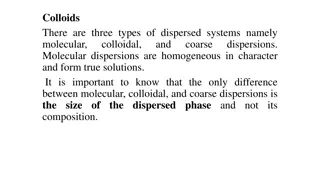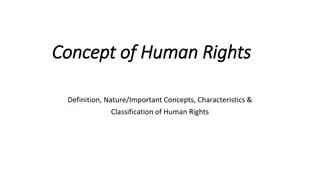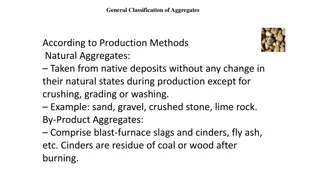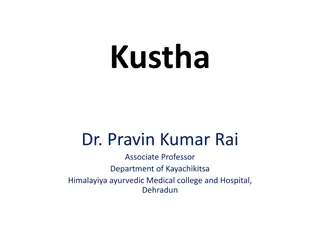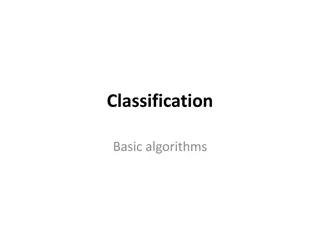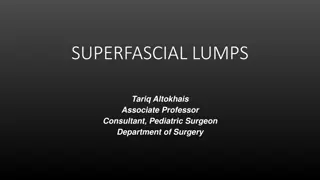Understanding Streptococci: Classification and Characteristics
Streptococci are Gram-positive cocci commonly found in chains or pairs. This article covers their classification based on hemolysis patterns and Lancefield grouping, along with general characteristics and principles of differentiation tests. Learn about the infections caused by different Streptococcus species and how to differentiate them under a microscope. Explore the significance of polysaccharide antigens in Serology and the impact of oxygen requirements on growth.
Download Presentation

Please find below an Image/Link to download the presentation.
The content on the website is provided AS IS for your information and personal use only. It may not be sold, licensed, or shared on other websites without obtaining consent from the author. Download presentation by click this link. If you encounter any issues during the download, it is possible that the publisher has removed the file from their server.
E N D
Presentation Transcript
Microbiology lab 6 Microbiology lab 6 Gram- positive cocci: Streptococci Asst. Prof. Shaima aAl-Salihy 1
Learning objectives: After this lab. You must be able to: Describe streptococci under microscope. Classify streptococcus spp. according to hemolysis pattern> Classify streptococcus spp. according to Lancefield grouping. List infections caused by each of streptococcal spp. Differentiate each streptococcus spp. From each other. Discuss principles of differentiation tests of each streptococcal spp. Predict streptococcal causative agents causing clinical cases. 2
streptococci streptococci 1
General characteristics: 1. Gram-positive cocci, arranged in chains or pairs. 2. Non motile, non spore forming. 3. Some strains are capsulated, which are important in pathogenicity. 4. Catalase-negative. 5. Majority are facultative anaerobes, few are obligate anaerobes. 6. They are fastidious microorganisms grow on enriched media such as blood agar, have small, pin head, opaque, circular colonies. 7. Sensitive to drying, heat, and disinfectant. 2
Classification: Species of this genus is classified according to the following: I. Hemolysis: - hemolysis: complete destruction of RBCs. e.g. S. pyogenes -hemolysis: partial destruction of RBCs e.g. S. mutans , S. pneumoniae. -hemolysis: non-hemolysis. 3
Hemolysis on Blood agar -hemolysis -hemolysis -hemolysis 4
II. Serology (Lancefield grouping): There are differences in the polysaccharide antigens (group-specific carbohydrate) Depending on these specific polysaccharide antigens, streptococci are named as groups fromA-H & K-W. of the cell wall. Streptococci Lanciefield classification Group A S. pyogenes Group B S. agalactiae Group C S. equisimitis Group D Enterococcus Other groups (E-U) 5
Classification Based on O2 Anaerobes Aerobes Peptostreptococci Growth on BA hemolysis hemolysis hemolysis Incomplete hemolysis (green color) Complete hemolysis / / no hemolysis Lancefield grouping (specific C carbohydrate Ag on cell wall Enterococcus fecalis Strep. viridans Strep. pneumoniae Group A U (21 groups) Griffith typing of Group A on MTR proteins into > 100 types 6
Human Streptococcal Pathogens S. pyogenes S. agalactiae Viridans streptococci S. pneumoniae Enterococcus faecalis 10
Human streptococcal pathogens: -hemolytic I. Group A streptococci - S. pyogenes: Most pathogen Inhabits throat, nasopharynx and occasionally skin serious streptococcal 7
Pathogenicity of S. pyogenes: a) Pyogenic pyoderma necrotizing fasciitis (flesh eating), septicemia, b) Toxin- mediated: puerperal fever, scarlet fever, and streptococcal toxic shock syndrome. c) Post streptococcal (immunogenic) hypersensitivity response - rheumatic fever (after sore throat), acute glomerulonephritis (after skin infection). infections: (impetigo), sore throat, erysipelas, streptococcal cellulitis, infection: a 8
Pharyngitis and tonsillitis Strep Throat S.pyogenes is leading cause of uncomplicated bacterial pharyngitis and tonsillitis Common in winter and early spring in children over age 3 Typical symptoms: Pus in throat Reddened and inflamed tonsils and uvula Tiny, reddish-brown spots at back of throat Swollen lymph nodes and tongue 13 http://www.lib.uiowa.edu/hardin/md/strepthroat.html
Erysipelas 11
Lab diagnosis Strep. pyogenes Specimens: throat swab, pus, blood Microscopy :Gram stain - GPC in chains Culture: BA - beta hemolytic colonies Identification tests - Catalase Negative Bacitracin sensitive ASO titer /Ab. titer: normal < 200< positive result. B -ve B +ve 16
Anti- Streptolysin O Test (ASOT): Principle: ASOT this test is serological test used in post streptococcal infection complications depending on the presence of antistreptolysin-O antibody in the blood of patient s previously infected with S. pyogenes. Ab. titer: normal < 200< positive result. 17
Bacitracin sensitivity Principle: Bacitracin test is used for presumptive identification of groupA To distinguish (susceptible to B) & non group A such as S. agalactiae (Resistant to B) Bacitracin will inhibit the growth of group A Strep. pyogenes giving zone of inhibition around the disk Procedure: Inoculate BAP with heavy suspension of tested organism Bacitracin disk (0.04 U) is applied to inoculated BAP After incubation, any zone of inhibition around the disk is considered as susceptible between S. pyogenes 18
-hemolytic : II. Group B streptococci- S. agalactiae: Normal flora of female vaginal tract and cause meningitis. Bacitracin resistant CAMP test Atkins, Munch-Peterson) hipurate hydrolysis test +ve (split sodium hippurate and give deep purple color indicate +ve response in this test) neonatal +ve (Christie, 16
CAMP test Principle: Group B streptococci produce diffusible extracellular protein (CAMP factor) CAMP act synergistically with staph. -lysin to cause lysis of RBCs Procedure: Single streak of unknown Streptococcus to be tested and a Staph. aureus are made perpendicular to each other 3-5 mm distance was left between two streaks After incubation, a positive result appear as an arrowhead shaped zone of complete hemolysis S. agalactiae is CAMP test positive while non group B streptococci are negative 20
CAMP test 21
Group D streptococci: Enterococcus faecalis and Enterococcus faecium: Streptococcal-like with group D antigens were at first classified in the genus Streptococcus but studies has revealed that they differ in many biological aspects. They are normal flora of GIT. Bile- esculin +ve Causes UTI, wound infection, bed sore, endocarditis. One of the most frequent cause of nosocomial infections particularly in ICU. Very resistant to antibiotics ( many isolates are resistant to cephalosporines even vancomycin). 19
Lab diagnosis - Enterococcus Specimens: urine, pus, blood Microscopy: Gram stain - GPC in pairs or short chains Culture: BA - alpha / beta / no hemolysis Identification tests - Catalase Negative - Bile esculin positive - Growth in 6.5% Nacl - Penicillin resistance 23
Differentiation between -hemolytic streptococci The following tests can be used to differentiate between -hemolytic streptococci Lanciefield Classification Bacitracin susceptibility Test Specific for S. pyogenes (Group A) CAMP test Specific for S. agalactiae (Group B) 24
Alpha hemolytic streptococci Streptococcus viridans 1 They contain many species. Normally present on teeth, throat, colon & female genital tract They adapted to non-invasive mode of life and enforced to inter human body. Pathogenicity The most serious infection -Subacute bacterial endocarditis- Blood-borne bacteria settle and grow on heart lining or valves Colonization of heart by forming biofilms. Dental caries 26
Alpha hemolytic streptococci Streptococcus pneumoniae (Pneumococcus) 1 General features: Causes 60-70% of all bacterial pneumonias Small, lancet-shaped cells arranged in pairs and short chains Culture requires blood or chocolate agar, Growth improved by 5-10% CO2 5-50% of all people carry it as normal flora in the nasopharynx; infections are usually endogenous Virulence factor capsule 28
Pathogenicity Otitis media, sinusitis commonest Pneumonia (Pneumonia occurs when cells are aspirated into the lungs of susceptible individuals, Pneumococci multiply and induce an overwhelming inflammatory response) Gains access to middle ear by way of eustachian tube. Meningitis Other suppurative lesions - Pericarditis, conjunctivitis, arthritis, peritonitis 27
Lab. diagnosis: Gram stain: GPC arranged in pairs. (lancet-shaped diplococci) presumptive identification to differentiate from pneumonia caused by viruses. Rapid diagnostic test: Quellung test or capsular swelling reaction for S. pneumoniae :is a Rapid diagnostic test on sputum or culture. By mixing S. pneumoniae with specific antipolysaccharide (capsule component) on microscopic slide. The capsule swells due Ag-Ab reaction. Culture: BA- -hemolytic Biochemical test: - optochin sensitivity: sensitive - bile solubility: soluble (+) - inulin fermentation (+) 31
Bile Solubility test Principle: S. pneumoniae produce a self-lysing enzyme to inhibit the growth The presence of bile salt accelerate this process Procedure: Add ten parts (10 ml) of the broth culture of the organism to be tested to one part (1 ml) of 2% Na deoxycholate (bile) into the test tube Negative control is made by adding saline instead of bile to the culture Incubate at 37oC for 15 min Record the result after 15 min 32
Bile Solubility test Results: Positive test appears as clearing in the presence of bile while negative test appears as turbid S. pneumoniae soluble in bile whereas S. viridans insoluble 33
Optochin Susceptibility Test Principle: Optochin (OP) test is presumptive test that is used to identify S. pneumoniae S. pneumoniae is inhibited by Optochin reagent (<5 g/ml) giving a inhibition zone 14 mm in diameter. Procedure: BAP inoculated with organism to be tested OP disk is placed on the center of inoculated BAP After incubation at 37oC for 18 hrs, accurately measure the diameter of the inhibition zone by the ruler 14 mm zone of inhibition around the disk is considered as positive and 13 mm is considered negative S. pneumoniae is positive (S) while S. viridans is negative (R) 38
Inulin fermentation Test This test is useful to differentiate Pneumococci from other streptcocci as the latter do not ferment Inulin sugar while Pneumococci do ferment it. 38
Differentiation between -hemolytic streptococci The following definitive tests used to differentiate S. pneumoniae from viridans streptococci Optochin Test (sensitive) Bile Solubility Test (+) Inulin Fermentation (+) 36
Differences between Viridans Gp & Pneumococci Point Pneumococci Viridans Gp Morphology Capsulated, lanceolate, diplococci Oval or rounded in chains Quellung test + - Colonies Dome shaped Draughtsman Dome shaped Growth in liquid Uniform turbidity Granular turbidity with powdery deposits Bile solubility + - Inulin fermentation + - Optochin sensitivity + - Intraperitoneal inoculation in mice Fatal Infection Non-pathogenic 37
Overview of the Medically Important Gram Positive Cocci THANK YOU Family, Genus, species Characteristics Clinical manifestations FOR LISTENING Cocci in cluster; catalase-positive Staphylococcaceae Staphylococcus aureus Coagulase +ve, yellow-pigmented colonies Pyogenic infections, toxicoses S. epidermidis Coagulase -ve, whitish colonies, normal flora Foreign body infections Cocci in chains and in pairs, catalase- negative Streptococcaceae Streptococcus pyogenes Cocci in chains, Lancefield group A, - hemolysis Tonsillitis, scarlet fever, skin infections S. pneumoniae Diplococci, -hemolysis Pneumonia, otitis media, sinusitis S. agalactiae Chain-forming cocci, group antigen B, - hemolysis Meningitis/sepsis in neonates S. viridans Cocci in chains, -hemolysis Endocarditis, dental caries Enterococcaceae In chains & pairs, , , or -hemolysis, group antigen D, catalase -ve Flora of intestines of humans and animals Enterococcus faecalis Enterococcus faecium 39 Aesculin-positive, growth in 6.5% NaCl, pH 9.6 Opportunistic infections


